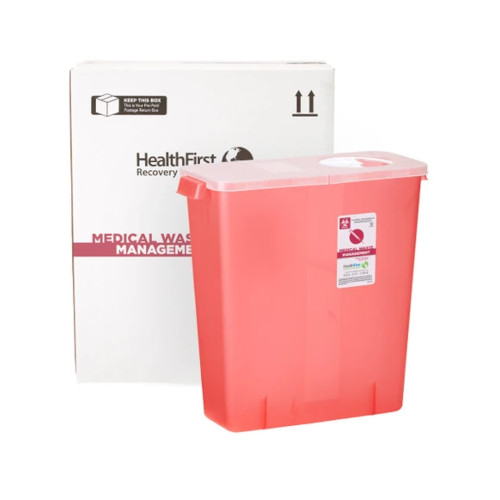Safe and Secure: The Clear-cut Selection for Specialist Medical Waste Removal Provider
Safe and Secure: The Clear-cut Selection for Specialist Medical Waste Removal Provider
Blog Article
Exploring Different Garbage Disposal Options for a Cleanser Setting
In the pursuit of a cleaner setting, the monitoring of waste disposal has emerged as a critical focal factor for sustainable advancement. With a wide range of waste disposal choices offered, varying from conventional garbage dump techniques to innovative waste-to-energy modern technologies, the choice of how we manage our waste has far-reaching effects for our planet's well-being.
Recycling Techniques
Executing efficient recycling approaches is critical in minimizing waste and advertising sustainability in our setting. Reusing entails the procedure of converting waste products into recyclable items to stop unneeded disposal.
An additional essential recycling technique is composting, which entails breaking down natural waste like food scraps and backyard trimmings right into nutrient-rich soil. By integrating these different reusing techniques into our waste monitoring methods, we can considerably reduce our environmental impact and relocate in the direction of an extra lasting future.

Composting Strategies
Efficient waste administration techniques, such as reusing approaches, lead the way for a cleaner setting, and currently, shifting the focus to 'Composting Techniques', we discover lasting ways to disintegrate natural waste for ecological advantage. medical waste removal service.
Composting is a natural process that transforms organic waste, like food scraps and yard trimmings, right into a nutrient-rich dirt modification. The key to successful composting hinges on creating the best balance of environment-friendly materials, such as fruit and vegetable scraps, and brown products, like dried out branches and fallen leaves. These products decompose with the assistance of bacteria, damaging down the waste into important compost.
Traditional yard composting entails layering organic products in a container or stack and on a regular basis transforming the blend to aerate it. By utilizing composting methods, we can lower the quantity of waste sent out to landfills while creating a helpful item for enhancing soil and sustaining plant growth.
Incineration Cons and pros
Incineration, as a waste disposal technique, offers both benefits and drawbacks that warrant careful consideration in the realm of sustainable waste management methods. On the favorable side, incineration can significantly minimize the volume of waste, minimizing the requirement for land fill area and potentially decreasing greenhouse gas discharges.
Furthermore, the high first financial investment and functional costs of incineration facilities present financial obstacles, making it a much less affordable option compared to other waste monitoring methods. Careful tracking and law are vital to mitigate these adverse impacts and make the most of the advantages of incineration as part of a thorough waste administration technique.
Land Fill Monitoring Strategies
Garbage dumps play a critical role in waste monitoring and ecological conservation by giving a containment read more system for the disposal of strong waste products. By condensing the waste, the quantity is lowered, allowing for even more waste to be accommodated over time.
Additionally, the application of day-to-day cover techniques is important in decreasing odors, avoiding trash, and minimizing the destination of parasites. Treatment the disposed waste at the end of each day helps to have smells and prevent possible ecological contamination. In addition, the tracking of land fill gas exhausts and leachate degrees is critical in making sure that environmental standards are fulfilled and that any kind of possible risks to surrounding ecosystems are lessened.

Waste-to-Energy Technologies
Among the ingenious methods to waste administration entails using Waste-to-Energy innovations to transform strong waste into functional power sources. Waste-to-Energy (WtE) modern technologies encompass a series of processes that intend to remove power from waste materials with thermal, chemical, or organic ways. This conversion procedure not just decreases the quantity of waste that winds up in landfills but additionally creates useful power resources such as power, warm, or biofuels.
There are a number of methods of Waste-to-Energy conversion, including pyrolysis, incineration, and gasification. Incineration involves melting waste at high temperature levels to create heat and electricity. Gasification converts waste into a syngas, which can be made use of for power generation or chemical manufacturing. Pyrolysis breaks down organic materials making use of high temperature levels in the lack of oxygen, producing bio-oil, gas, and char.
Carrying out Waste-to-Energy technologies can help reduce environmental problems linked with standard garbage disposal techniques while at the same time providing a renewable resource resource. Nevertheless, careful consideration has to be given to emissions control and ensuring the sustainability of feedstock materials for these technologies to be truly helpful for a cleaner atmosphere.

Conclusion
Finally, discovering different garbage disposal alternatives such as recycling, composting, incineration, landfill management, and waste-to-energy innovations is essential for promoting a cleaner atmosphere - click here. Each approach has its very own benefits and difficulties, yet by making use of a mix of these techniques, we can work towards minimizing the amount of waste that winds up in land fills and ultimately add to an extra lasting future for generations to come
With a multitude of waste disposal choices available, varying from traditional land fill techniques to ingenious waste-to-energy innovations, the option of how we manage our waste has significant ramifications for our earth's well-being. medical waste disposal.Incineration, as a waste disposal technique, provides both advantages and downsides that merit careful factor to consider in the world of sustainable waste management methods.Land fills play an essential duty in waste administration and ecological preservation by giving a containment system for the disposal of strong waste products. By condensing the waste, the volume is lowered, allowing for more waste to be suited over time
One of the cutting-edge strategies to lose administration involves utilizing Waste-to-Energy technologies to transform solid waste into useful power resources.
Report this page